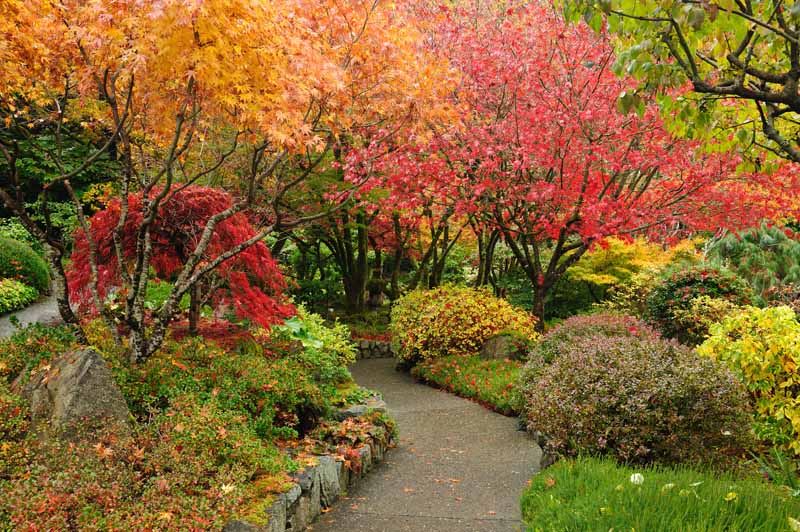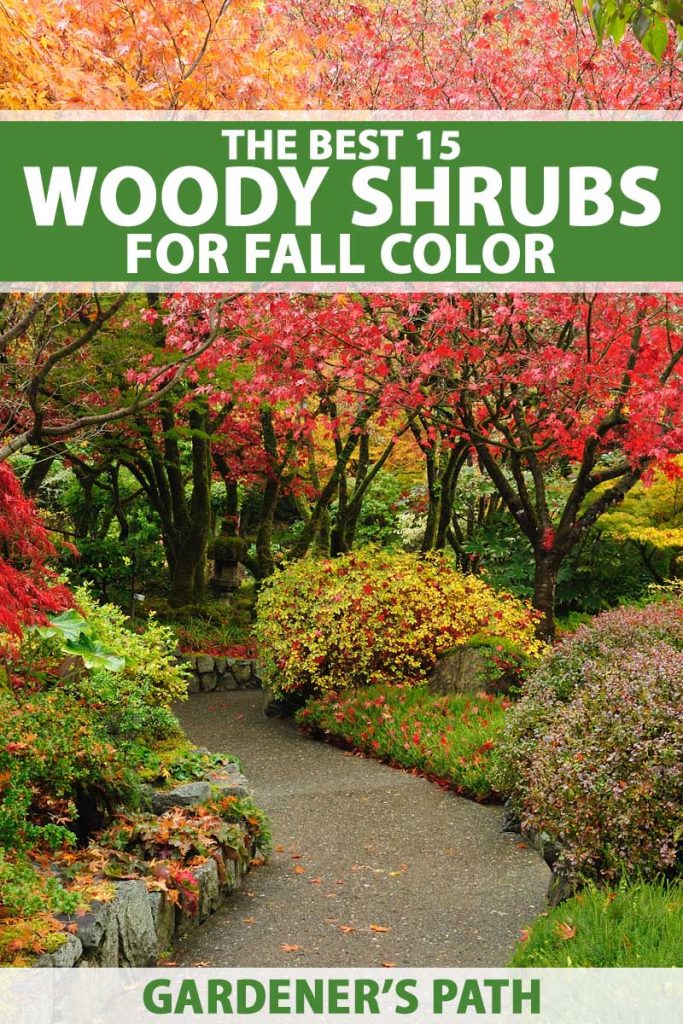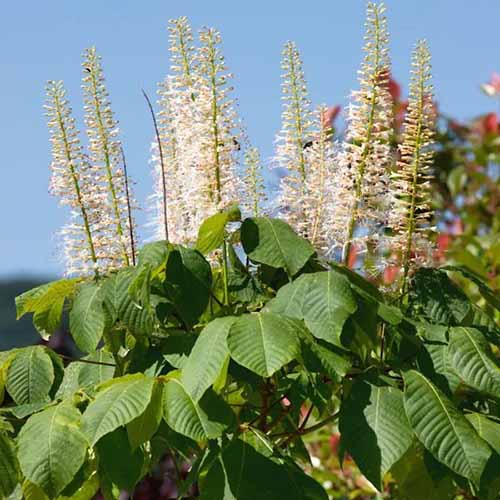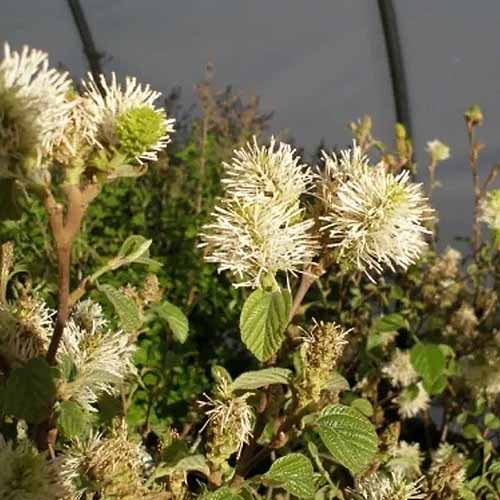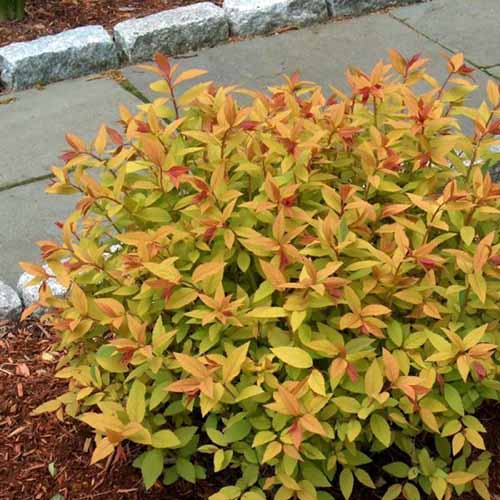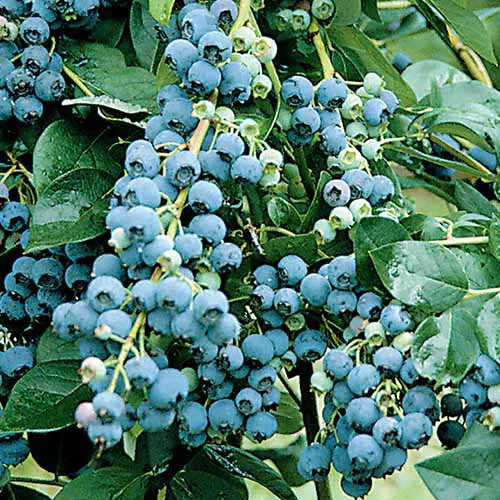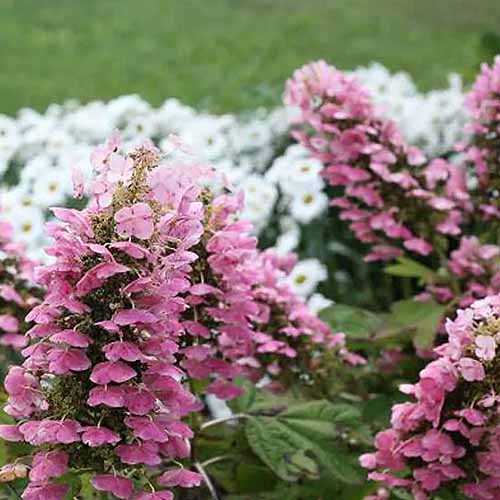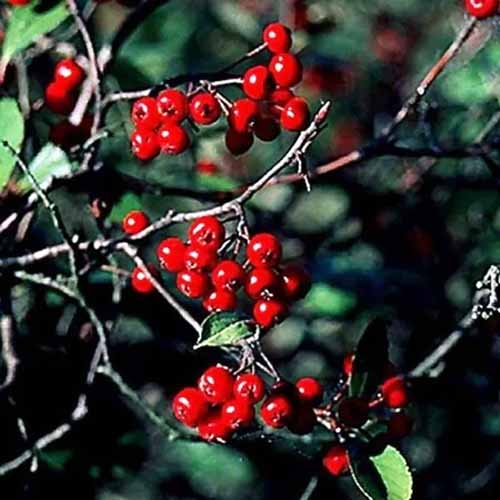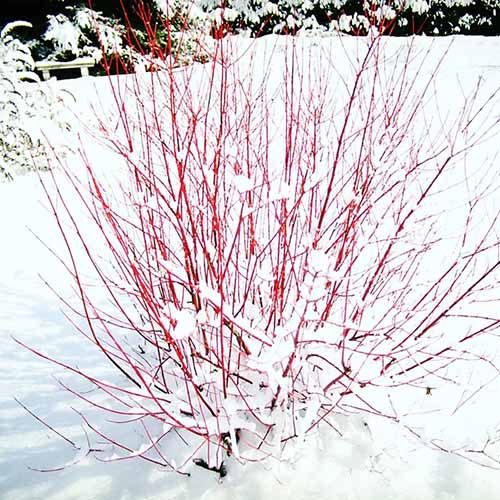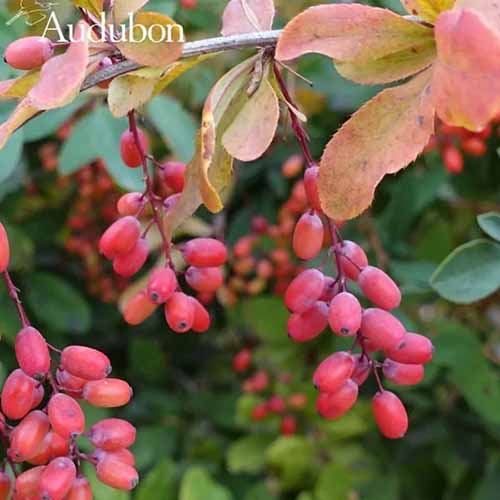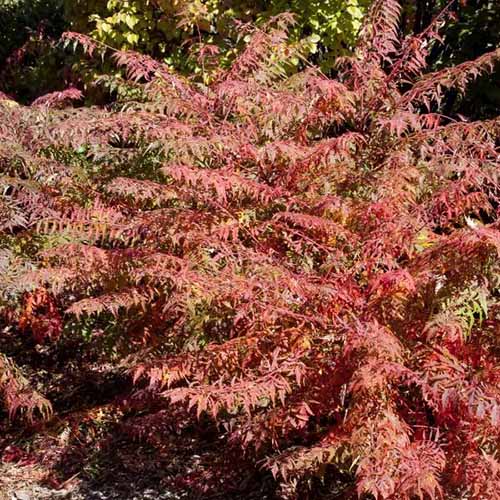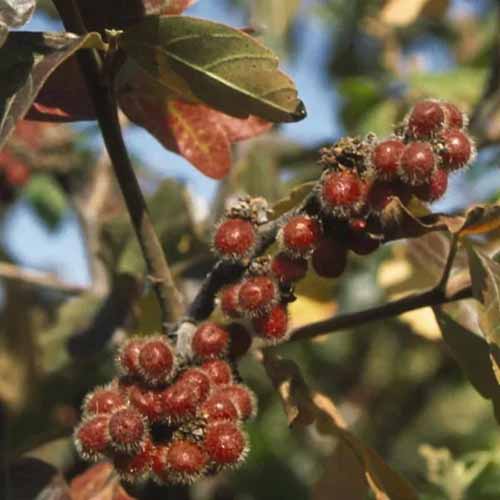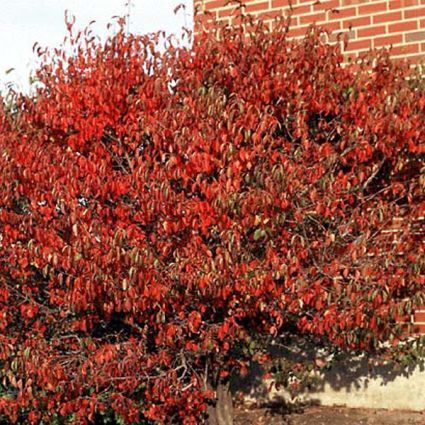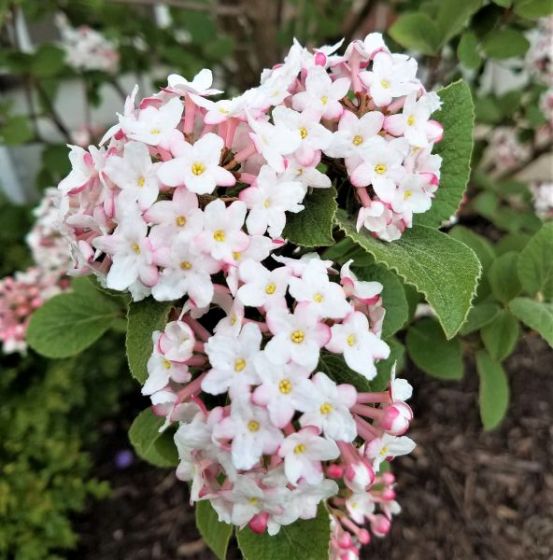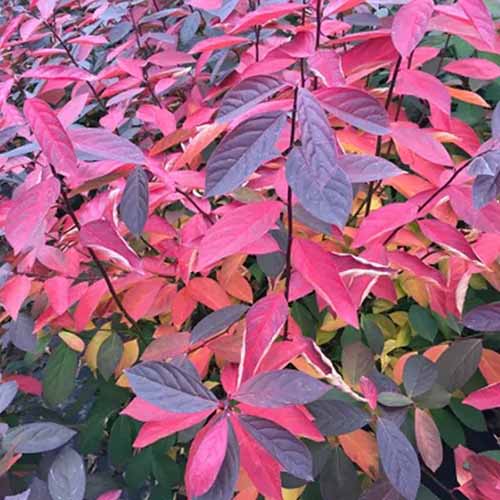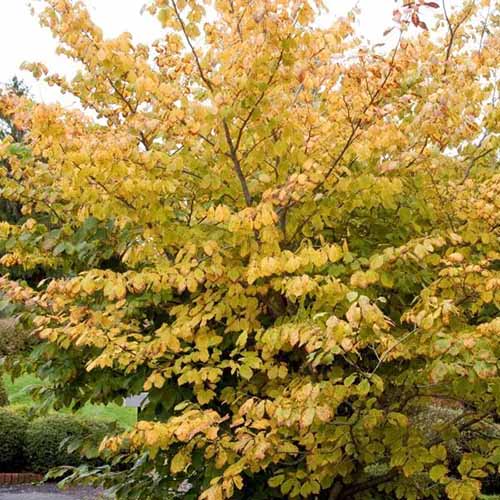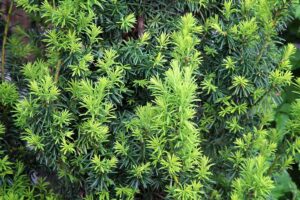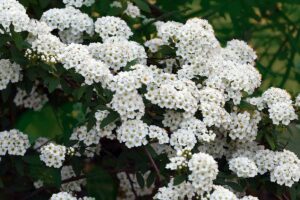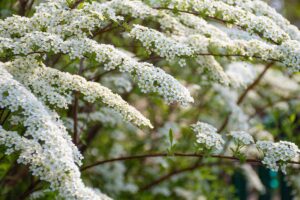The flora of spring and summer with their lush foliage and eye-catching flowers receive a lot of attention in the garden.
But we shouldn’t forget about autumn’s contribution to Mother Nature’s colorful palette.
Many deciduous shrubs and bushes shine brightly as the dog days of summer wane and a hint of fall’s crisp air begins to sneak in.
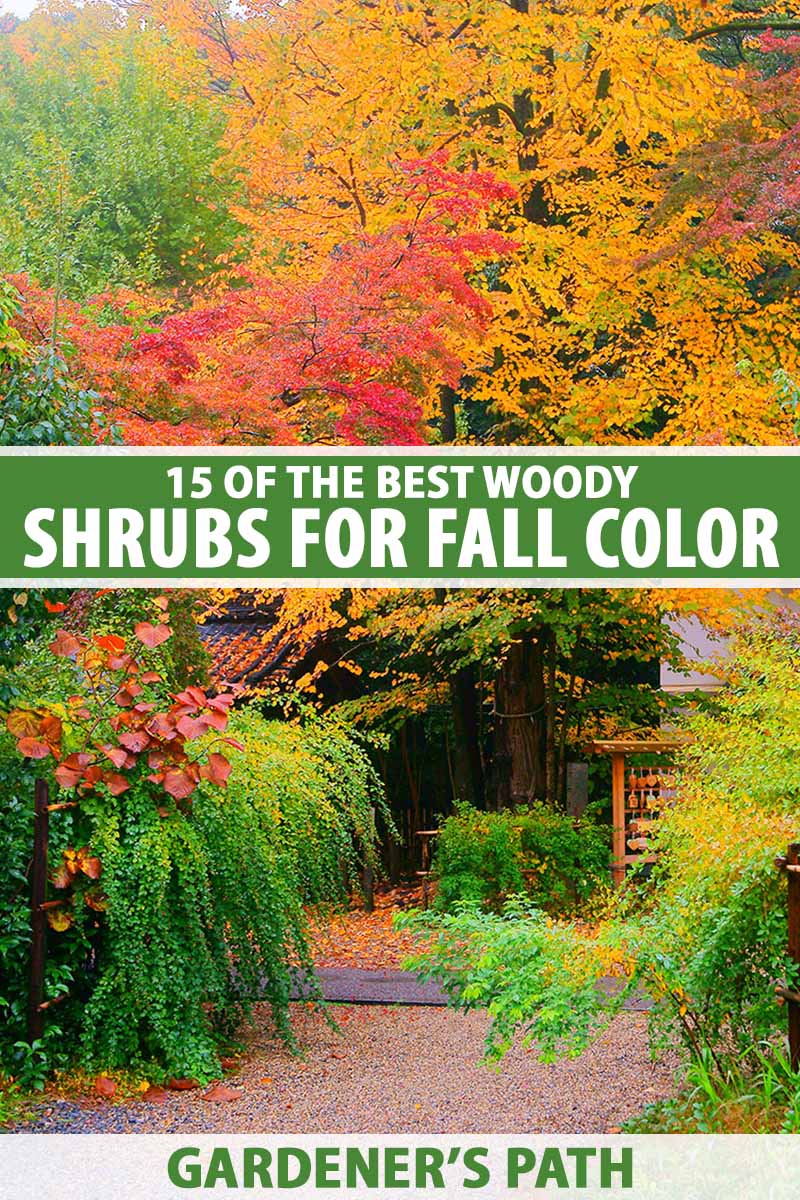
We link to vendors to help you find relevant products. If you buy from one of our links, we may earn a commission.
Let’s look at our top picks, a collection of woody shrubs that are particularly memorable and well-suited for landscapes east, west, north and south.
All of these selections add vivid color and will definitely make an impact in your landscape in the autumn and most can be grown throughout temperate North America and Europe.
1. American Beautyberry
American beautyberry, Callicarpa americana, is native to southern North America and suitable for cultivation in Zones 6 to 10.
In fall, the bright green leaves turn a fantastic shade of yellow which are beautifully set off by the clusters of bright purple BB-pellet-sized fruits.
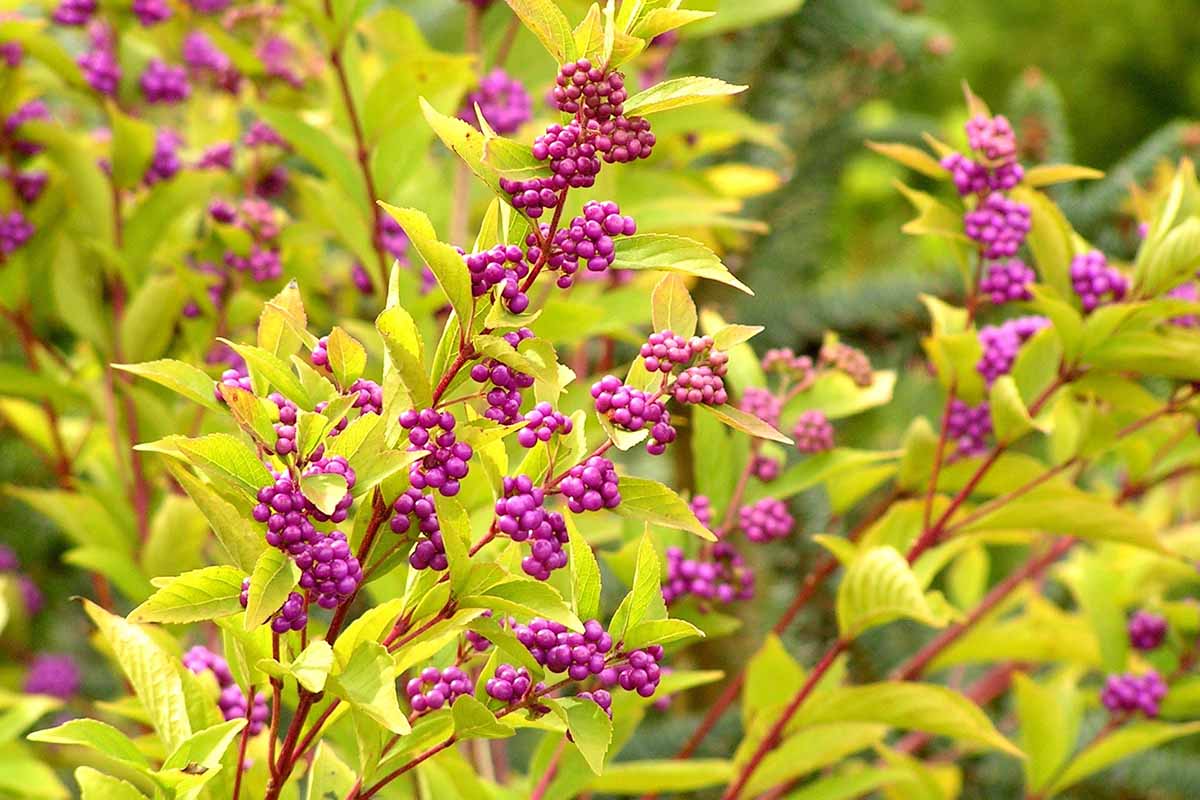
As a bonus for those looking for an understory shrub, this plant is shade tolerant – it prefers a part shade location. With a shrubby, open growth habit, this plant tops out at three to five feet tall and wide.
American beautyberry is not picky about soil, either, and it’s quite drought-resistant, though it does perform better with regular watering, especially when it’s young.
If you’d like to add American beautyberry to your garden, you can find plants in three-gallon pots available at FastGrowingTrees.com.
And you can check out our guide to growing American beautyberries here.
2. Bottlebrush Buckeye
Bottlebrush buckeye, Aesculus parviflora, is among the few shrubs on this list that prefers shady conditions. It even blooms profusely in the shade, developing long, upright spikes of white blossoms in late summer.
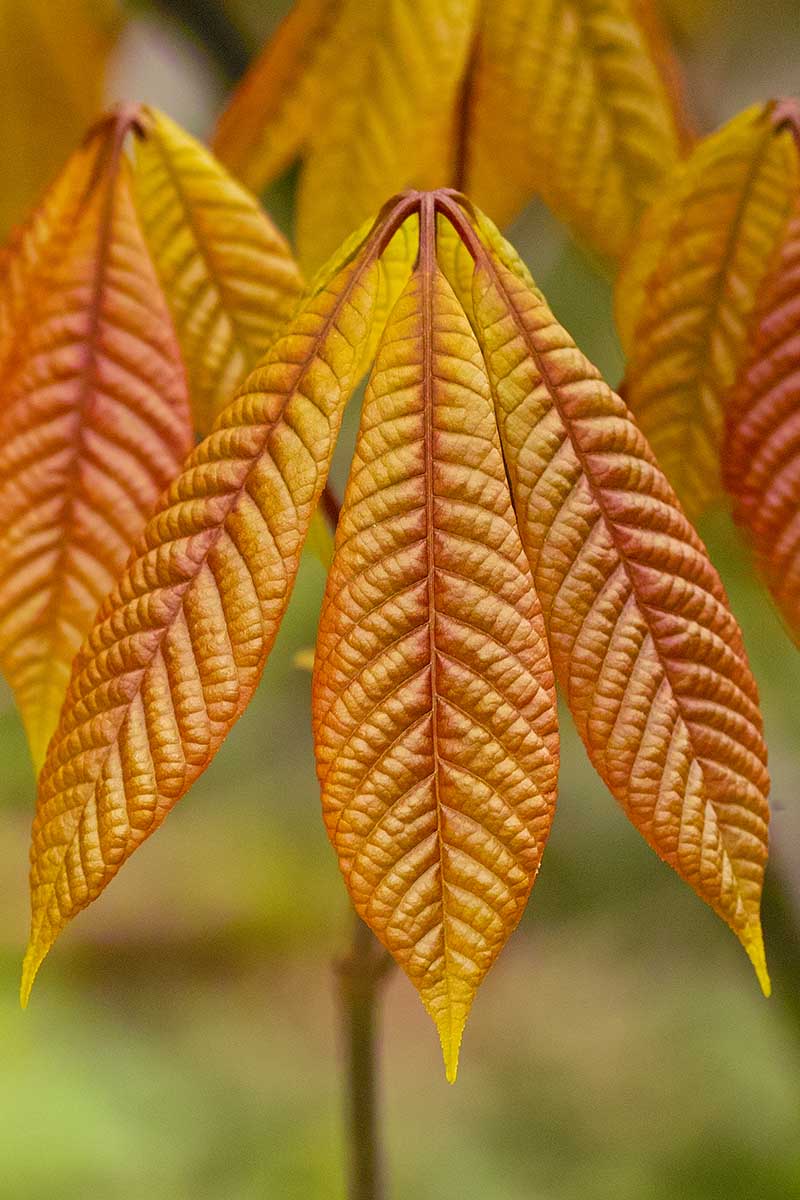
Its thick, light green leaves grow up to five inches in length and turn brilliant yellow to burnished orange in fall.
This plant prefers rich, moist loam, but will do fine in average soil providing it drains well. It is intolerant of dry soils, especially when young.
Native to North America, it has a dense, mounding growth habit reaching a mature height of eight to 12 feet with a width of eight to 15 feet. Bottlebrush buckeye is hardy in Zones 4 to 8.
You can find plants available at Nature Hills Nursery.
3. Crape Myrtle
As if its summer-long display of deep red or pink flowers weren’t enough, crape myrtle (Lagerstroemia indica) puts on a fall display too – with lovely yellow leaves.
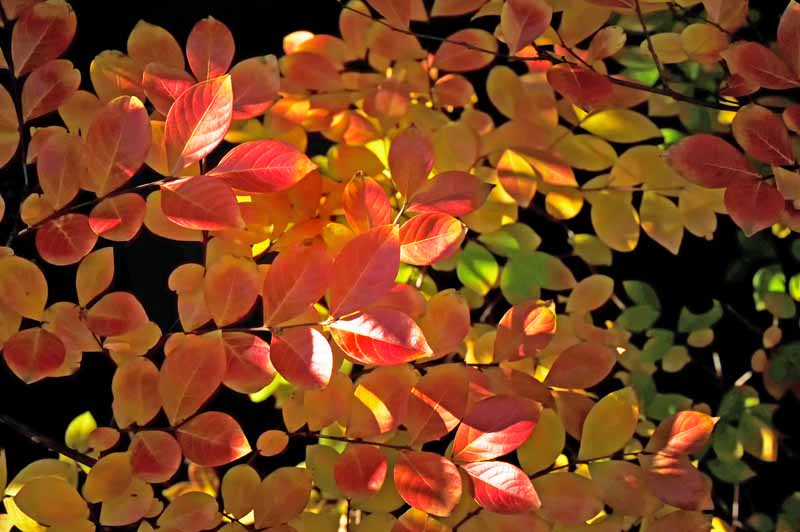
Crape myrtles are not picky about soil and can be quite drought-tolerant once established. They do require a full sun location and are suitable for cultivation in Zones 6 to 9.
Expect a mature height of three to six feet tall and a width of two to four feet.
Crape Myrtle with Pink Flowers
You can find L. indica with pink flowers available in #3 containers from Nature Hills Nursery.
4. Dwarf Fothergilla
Fothergilla gardenii is native to the southern US and does well in moist, acidic, organically rich, well-drained soils. This compact beauty flowers best in full sun, but the plant also appreciates some afternoon shade in hot and dry climates.

In spring, you’ll experience fragrant white bottlebrush-like flowers in one- to two-inch clusters. Come autumn, expect to be dazzled by red, orange, and yellow leaves.
Suitable for growing in Zones 5 to 8, dwarf fothergilla grows to two to three feet tall and wide, with a mounding growth habit.
You can find plants available from Nature Hills Nursery.
5. Goldflame Spirea
Spiraea japonica ‘Goldflame’ has leaves that will make you happy from spring through fall.
They emerge bronze-red in the spring, mature to yellowish-green in summer, and then offer a vibrant yellow, copper, and orange show in autumn.
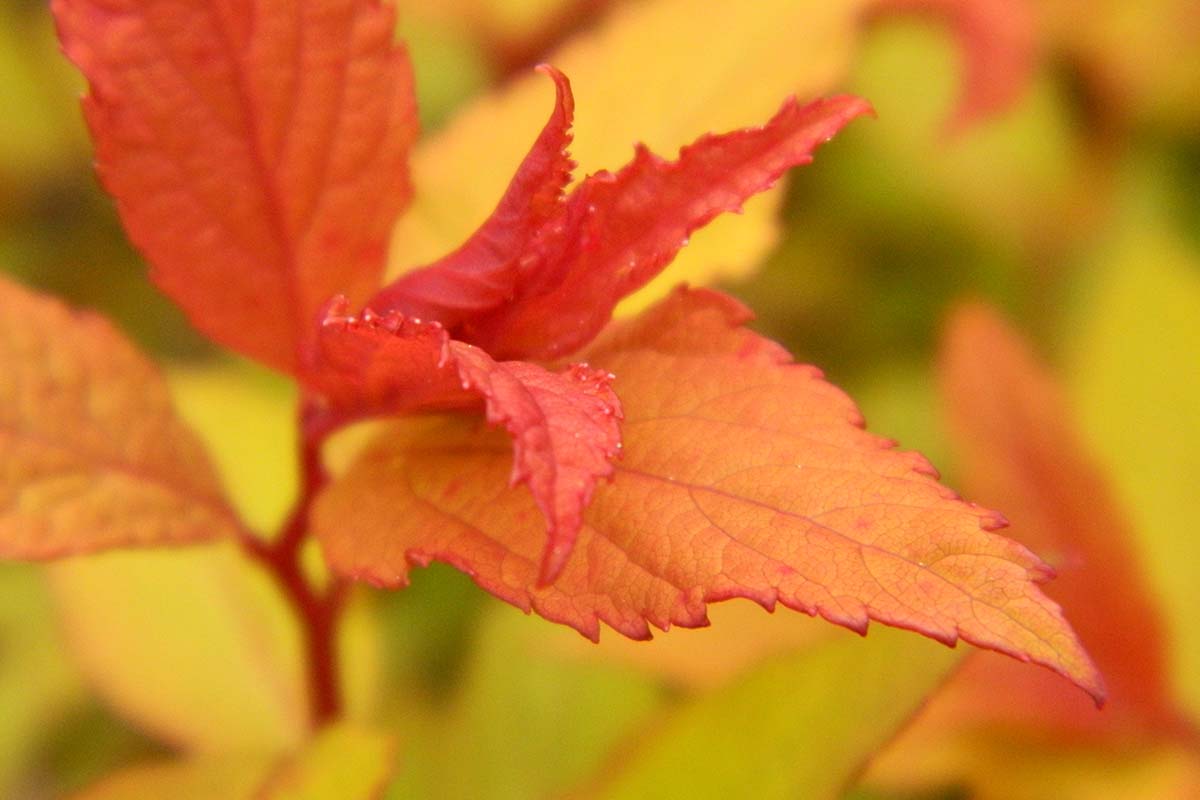
Like many of its colorful cousins, ‘Goldflame’ is a butterfly attractor. It thrives in loamy, medium-moist, well-drained soils in Zones 4 to 8.
Topping out at three to four feet tall and wide, this cultivar prefers a full sun location but will tolerate light shade.
S. japonica is native to Japan and can spread aggressively via suckers and seeds. It’s currently listed as invasive in many states including Alabama, Georgia, Kentucky, and Pennsylvania, so be sure to check before planting.
Plants in #1 and #3 containers are available from Nature Hills Nursery.
6. Highbush Blueberry
Highbush blueberry shrubs (Vaccinium corymbosum) don’t just provide ornamental interest in the garden, but you’ll enjoy a harvest of edible berries as well. Grow this tasty treat in acidic soil in a full to part sun location in Zones 3 to 7.
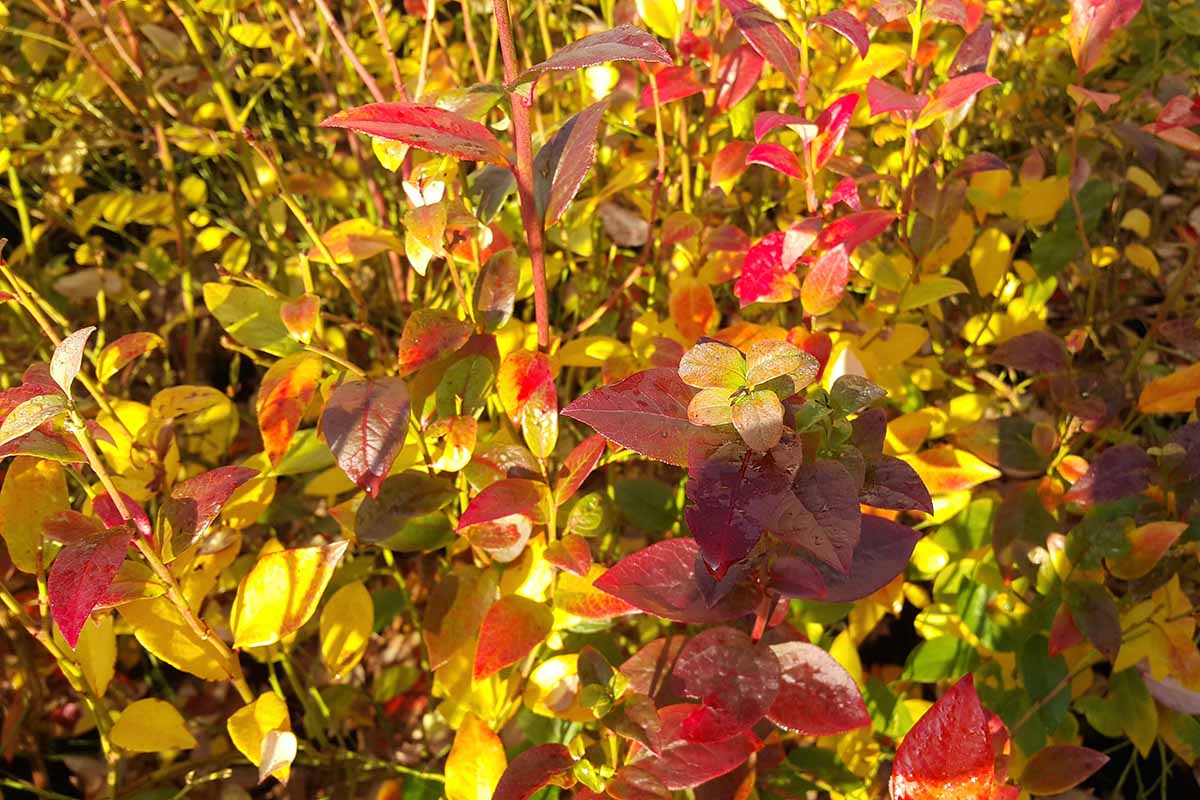
This plant, native to eastern Canada and eastern and southern US, shows off all year, with reddish-green spring leaves that turn blue green in summer and then red, yellow, purple, and orange in fall. The small berries ripen from July through August.
‘Jersey’ is a vigorous cultivar that produces medium sized berries on six- to eight-feet-tall plants. The green leaves turn a flaming orange in fall.
You can find ‘Jersey’ plants available from Burpee.
Read more about growing highbush blueberries shrubs here.
7. Oakleaf Hydrangea
Oakleaf hydrangea (Hydrangea quercifolia) is native to southeastern US that blooms with long, graceful panicles in pink, red, or white.
These shrubs prefer rich, well-drained, slightly acidic soil that stays evenly moist without becoming soggy. Easy to cultivate in Zones 5 to 9, they top out at four to 15 feet tall and wide.
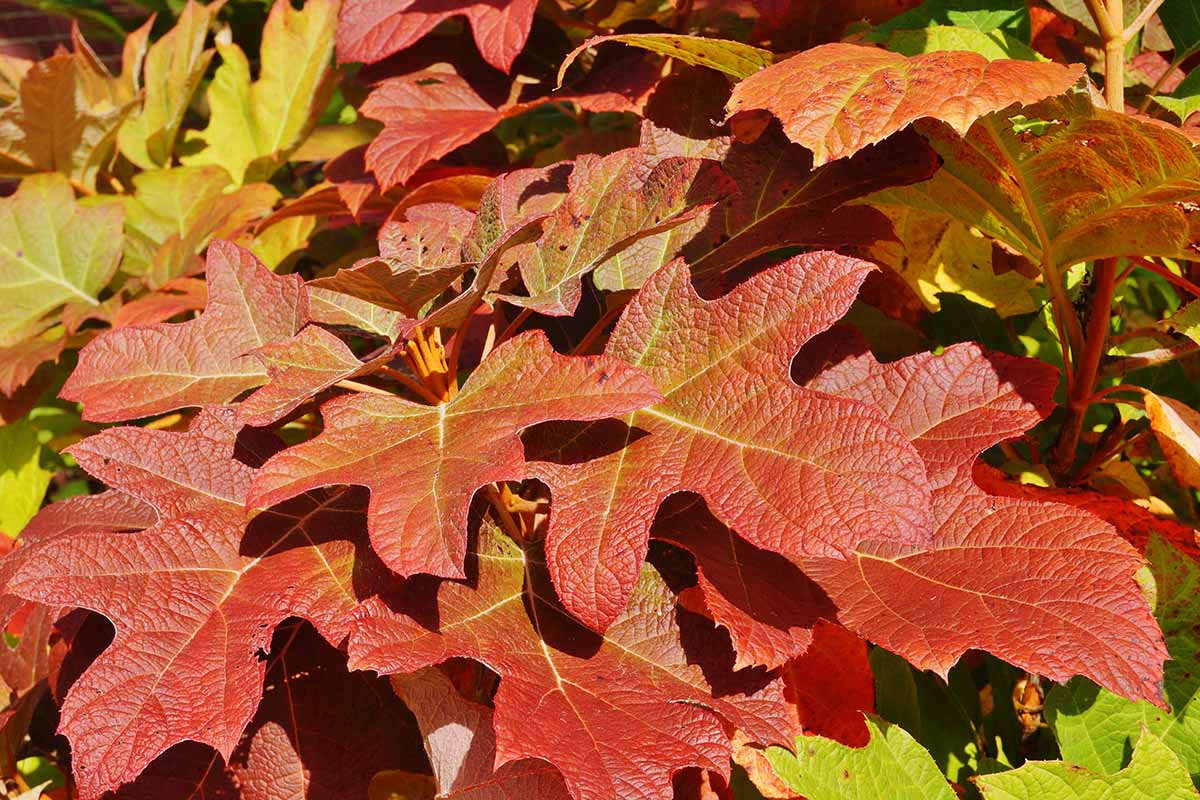
The oak-like leaves can grow up to 12 inches wide, and come fall, they transform into a radiant show of red, orange, gold, bronze and purple.
In some climates, the colorful display can last into the winter months. When the bush does drop its leaves, exfoliating cinnamon-brown bark is revealed.
Gatsby Pink® aka H. quercifolia ‘JoAnn’ sports bright pink blooms that last from midsummer into late fall.
You can find Gatsby Pink® available at Nature Hills Nursery.
8. Red Chokeberry
Native to the eastern United States, chokeberry (Aronia arbutifolia) offers seasonal interest year-round.
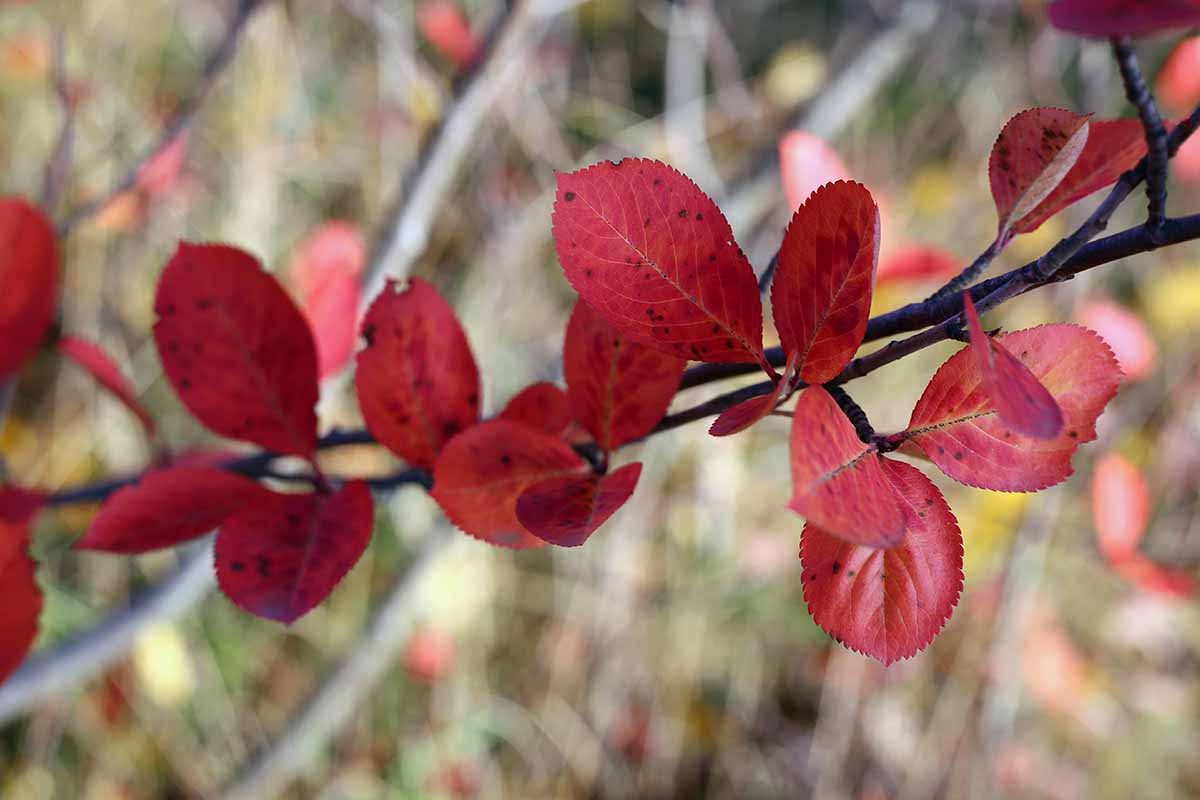
Clusters of very small white flowers arrive in spring, followed by copious amounts of small, glossy red fruit. Leaves are dark green on top and gray-green underneath, turning bright red to reddish-purple in fall.
This low-maintenance shrub thrives in a variety of soil types, and grows to a mature height of six to eight feet with a spread of three to four feet.
Red chokeberry is hardy in Zones 4 to 9 and needs at least six hours of direct sun daily.
Plants in #3 containers and two- to three-feet-tall bare roots are available from Nature Hills Nursery.
9. Red Osier Dogwood
Red osier dogwood (Cornus sericea) aka creek or red twig dogwood is native to North America and its stunning fall color comes not from the leaves but from the stems.
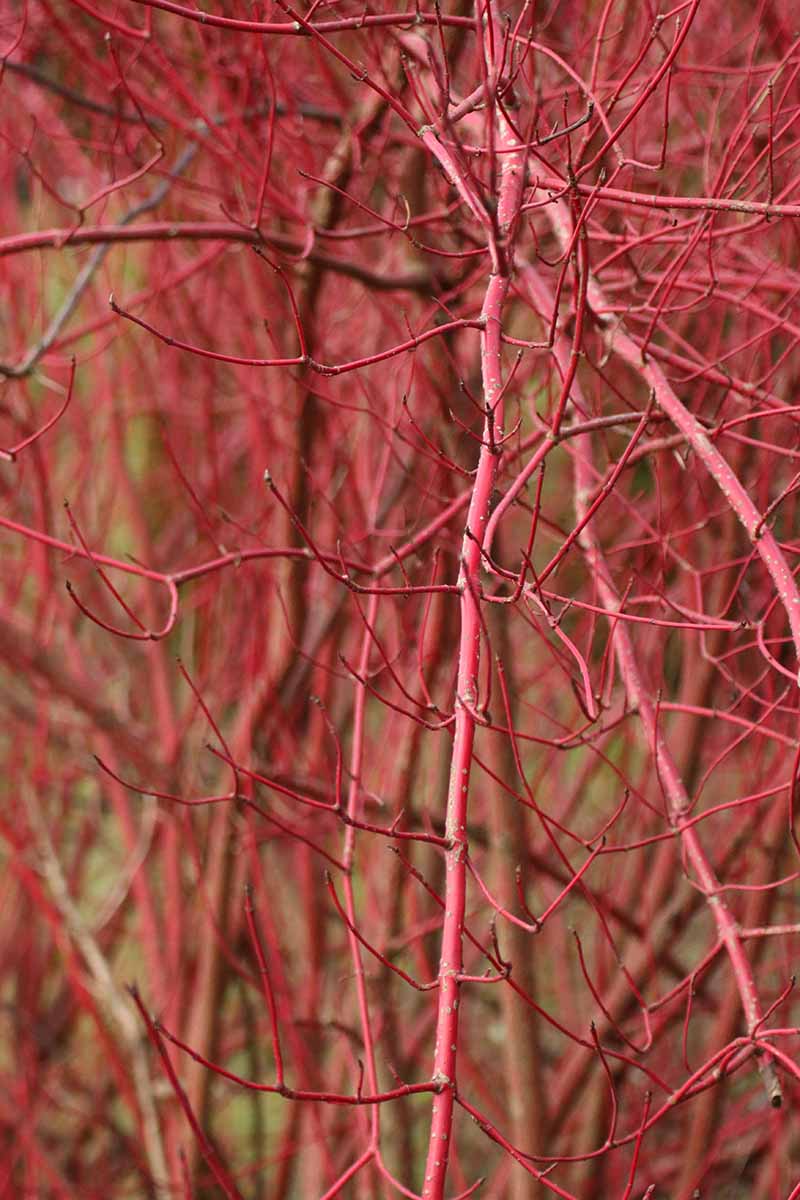
This deciduous shrub has an upright, spreading growth habit and its numerous stems turn a brilliant red in the fall.
In late spring, small white flowers are a magnet for butterflies and other pollinators, giving way to white berries. The deep green foliage turns reddish-purple in autumn before falling to the ground and revealing the gorgeous red stems.
Red osier dogwood is hardy in Zones 2 to 7 and needs about four hours of direct sunlight each day, but is fine with shade or dappled shade the rest of the day. Expect a mature height of seven to nine feet, with a spread of up to 10 feet.
You can find plants available at FastGrowingTrees.com in a choice of sizes.
Find tips on growing red osier dogwood here.
10. Spicebush
Spicebush (Lindera benzoin) is popular not only with humans but also with birds, deer, rabbits, raccoons, and opossums.
One type of butterfly likes spicebush so much that it took its name from the plant – Papilio troilus is commonly known as the spicebush swallowtail.
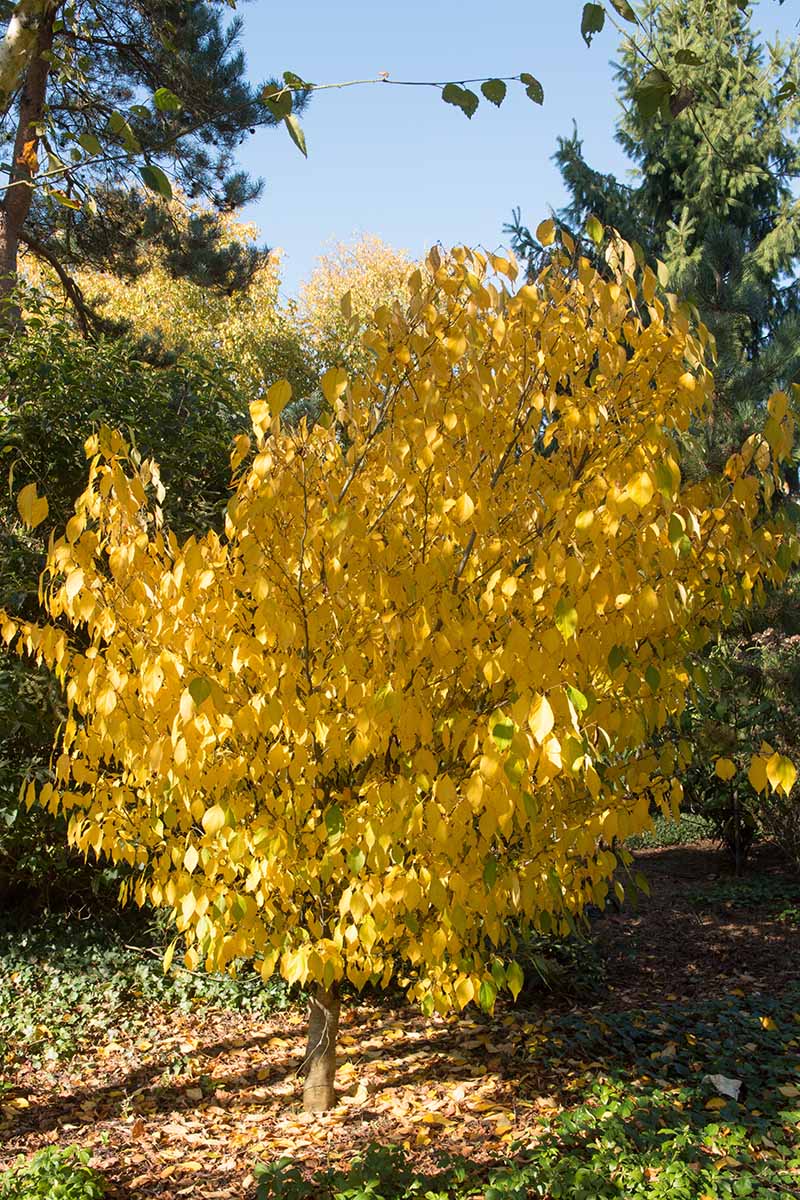
Native to North America and hardy in Zones 4 to 9, spicebush sports light green, fragrant leaves and in early spring the branches are adorned with yellow-green flower clusters that attract a variety of pollinators.
The foliage rings in autumn with a display of brilliant yellow leaves. The color is more vibrant when it is planted in full sun.
Spicebush is easy to grow in average soil, provided it drains well, and tops out at six to 12 feet tall and wide.
You can find one- to two-foot-tall plants available at Nature Hills Nursery.
11. Sumac
The Rhus genus consists of about 35 species commonly known as sumac and many types are renowned for their lovely fall color.
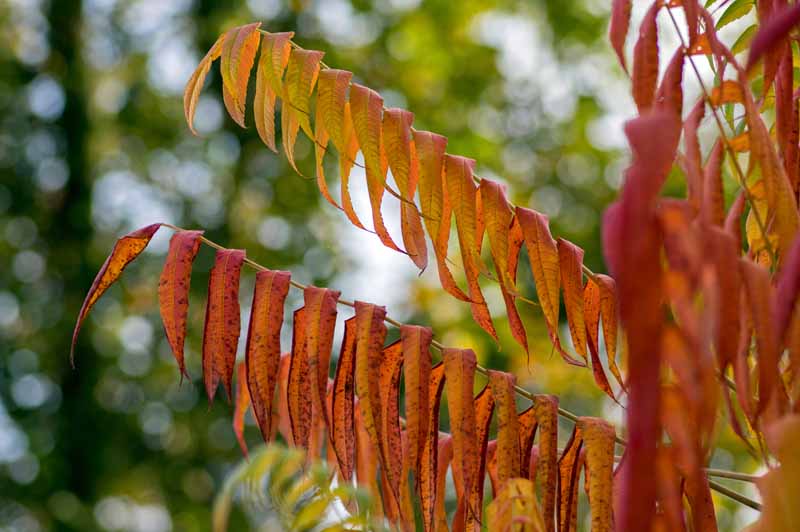
Here are a couple of standouts to look for:
Cutleaf staghorn sumac (Rhus typhina ‘Dissecta’) grows best in Zones 4 to 8. You can expect it to reach heights of nine to 15 feet, with a spread of 15 to 20 feet.
This species grows big enough that some might call it a tree, but its wide spread, multiple stems, and aggressive thicket-forming habit put it more in the shrub category.
Whatever you call it, it’s a beauty, especially come autumn when the long, deeply serrated leaves turn yellow, orange, and red.
This one likes average soil that drains well. It appreciates full sun but will tolerate some shade, and it is drought-tolerant once established.
Plants are available from Nature Hills Nursery.
Fragrant Sumac (R. aromatica) may be grown in Zones 3 to 9. It’s a smaller shrub, maxing out at two to six feet tall and six to 10 feet wide.
While related to poison sumac (Toxicodendron vernix), fragrant sumac is not poisonous and its leaves offer a pleasant scent when crushed.
The trifoliate green leaves turn yellow, orange, red, and purple in autumn, offering a spectacular display of fall color.
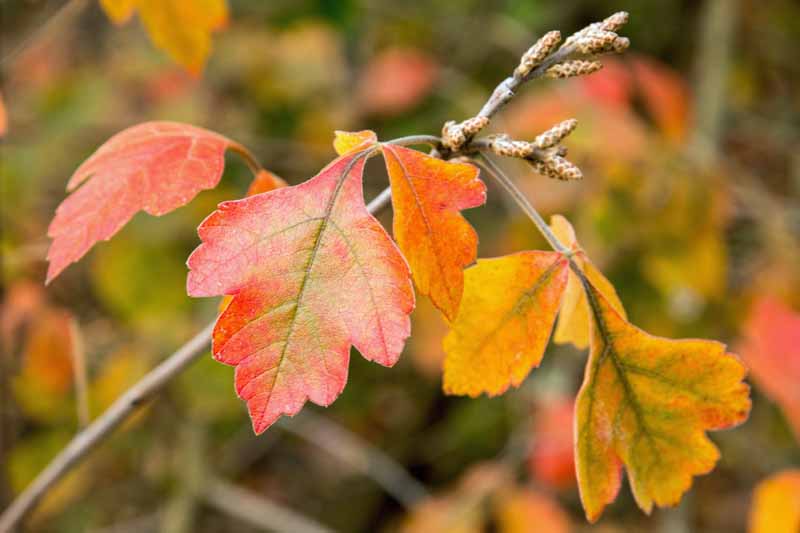
This low-maintenance beauty does well in much of the United States, requiring part shade to full sun, and needing low to moderate amounts of water.
It prefers well-drained soils and thrives in difficult areas.
You can find three- to four-feet-tall bare root plants available at Nature Hills Nursery.
12. Turpentine Bush
Native to the southwestern United States and northern Mexico, turpentine bush (Ericameria laricifolia) likes it hot, and rewards with numerous tiny yellow flowers in late summer and fall.
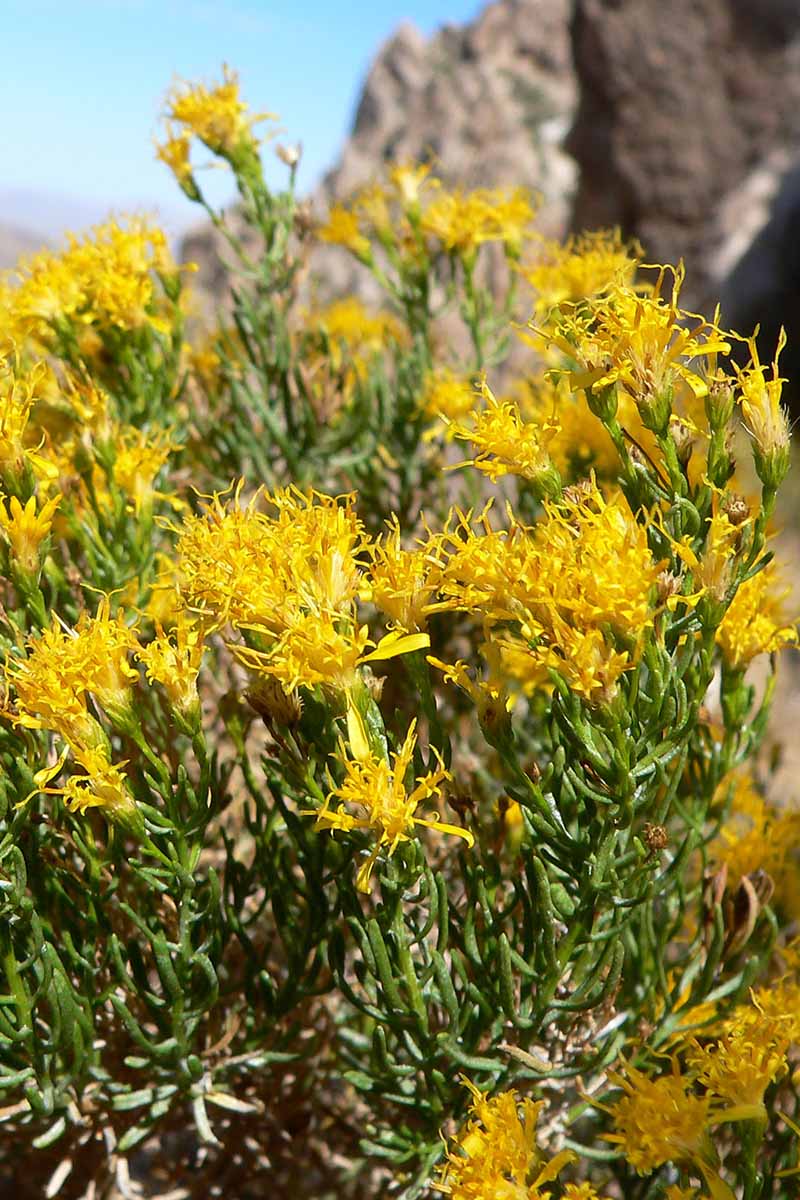
Its common name comes from the fact that the foliage is covered with a resin that, when touched, smells like turpentine. Its other common name is narrowleaf goldenbush.
This evergreen plant grows best in Zones 7 to 10, and thrives in poor, dry soils that are low in organic material. It’s tolerant of sandy soils and those containing limestone.
Turpentine bush is drought tolerant and tops out at one to three feet tall and wide.
Or read our detailed Ericameria laricifolia growing guide here.
13. Viburnum
A number of viburnum species display brilliant fall color, and it’s too hard for us to pick just one!
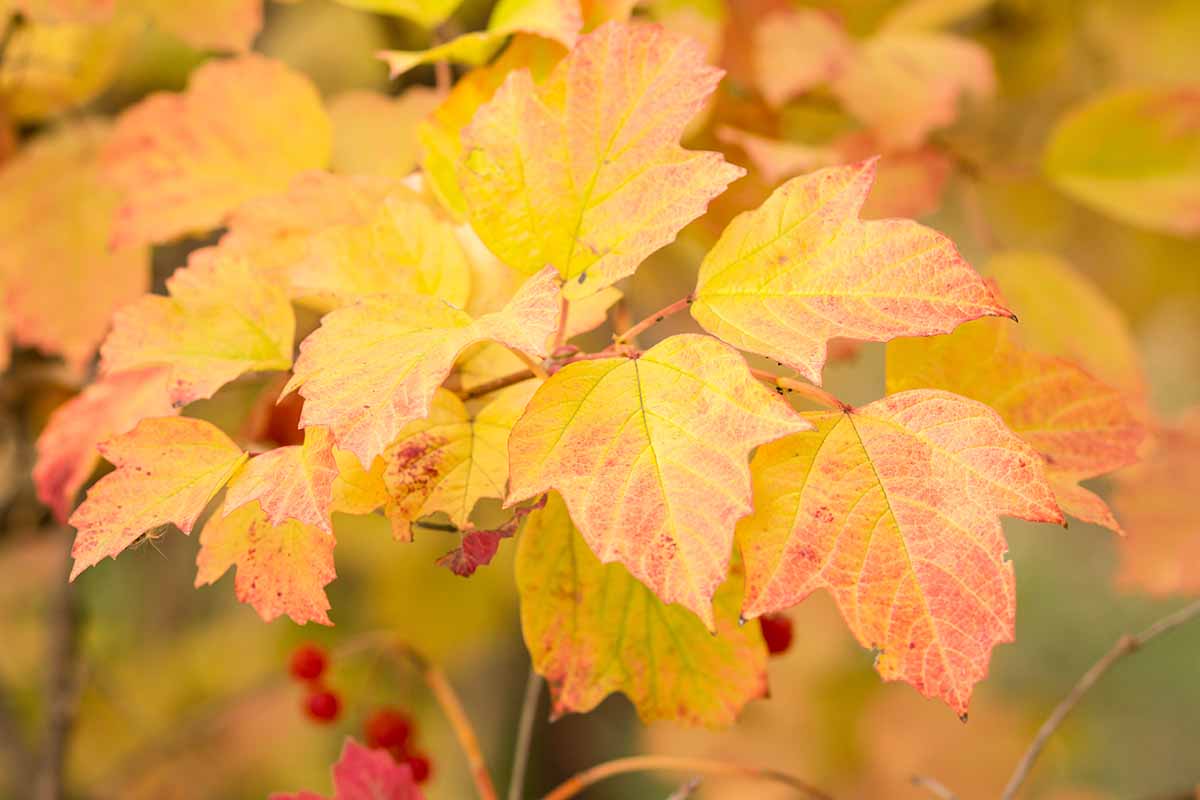
Blackhaw, for example, shows off not only purple, reddish-bronze, or crimson leaves, but also blue-black berries in autumn.
It will tolerate drought and may be planted in clay soil. It likes full sun to part shade.
‘Forest Rouge’ Blackhaw Viburnum
This type grows best in Zones 3 to 9, and can reach heights of 12 to 15 feet and widths of eight to 10 feet at maturity.
‘Forest Rouge’ blackhaw plants (Viburnum prunifolium ‘McKRouge’) are available from Nature Hills Nursery.
V. nudum ‘Winterthur’ aka smooth witherod is another gorgeous option. It produces showy, fragrant white flowers in the spring, and the foliage turns deep red in the fall.
‘Winterthur’ appreciates full sun to light shade and wet to moderately dry soils. It can be grown in Zones 5 to 9 and will reach a mature height of about six feet tall with a spread of five to 12 feet.
Korean spice (V. carlesii) is another enticing option. This low-maintenance plant likes a moderate amount of water and prefers full sun to partial shade. The foliage turns various shades of red in autumn.
It will grow happily in Zones 4 to 7, maxing out at about four to six feet in height and width.
Plants are available from Nature Hills Nursery in #3 and #5 containers.
Finally, consider arrowwood (V. dentatum), another viburnum to look for if you’re after cool-weather color.
‘Autumn Jazz’ Arrowwood Viburnum
Its lustrous, dark green leaves change to glossy red and reddish-purple in the fall. Half-inch dark blue berries ripen in early fall.
It thrives in Zones 2 to 8, and you can expect it to reach five to nine feet tall and wide at maturity.
‘Autumn Jazz’ arrowwood viburnum plants are available from Nature Hills Nursery. Choose from three- to four-feet bare roots or #5 containers.
Read more about growing viburnum here.
14. Virginia Sweetspire
Virginia sweetspire (Itea virginica) is native to the eastern United States and it flourishes in average, well-drained soil. It prefers moist, humus-rich soils, but will tolerate a wide range.
It will do well in full sun to part shade locations in Zones 5 to 9, reaching a mature height of three to four feet with a spread of four to six feet.
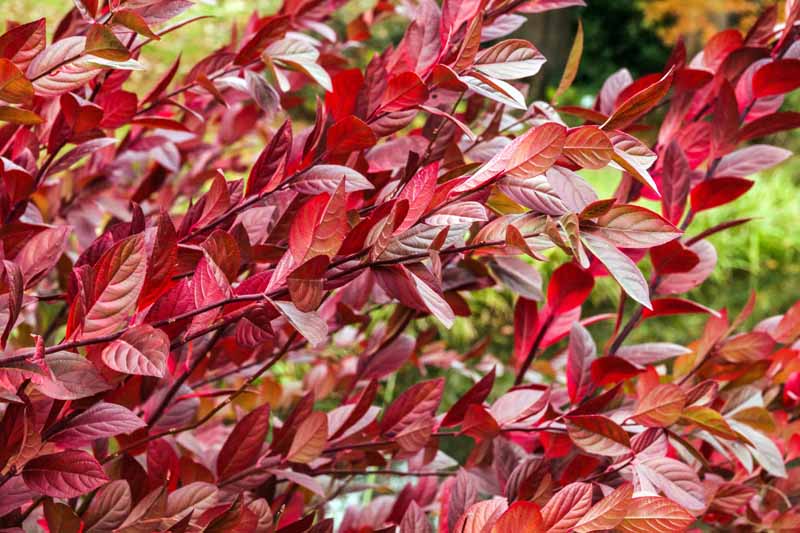
Virginia sweetspire bears fragrant, tiny white flowers borne in three- to six-inch-long cylindrical clusters. Its dark green oval leaves turn varying shades of gold, red, purple, and orange in autumn.
Scentlandia® is a dwarf cultivar that tops out at two to three feet tall and wide. It features highly fragrant white blooms in the summer months and vibrant red and deep purple foliage come fall.
You can find Scentlandia® plants in #3 containers available at Nature Hills Nursery.
15. Witch Hazel
Common witch hazel, Hamamelis virginiana, puts on a dazzling autumn show with fragrant yellow flowers featuring strap-like, crumpled petals that are similar to those of Chinese fringe flower.
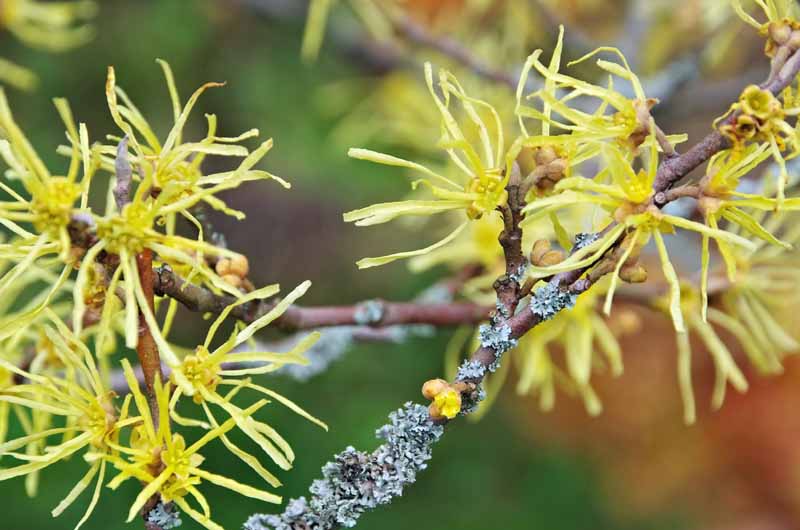
Witch hazel prefers full sun to part shade and doesn’t mind clay soils, though it does perform best in moist, well-drained dirt.
This plant is hardy in Zones 3 to 8 and can grow to be 15 to 30 feet tall and wide, but many gardeners like to keep it pruned to a smaller shrub size.
Extracts of the plant’s leaves, twigs, and bark is used in the cosmetics industry as an astringent.
You can find one- to two-feet bare root common witch hazel plants available at Nature Hills Nursery.
Learn more about growing witch hazel here.
Autumnal Awesomeness
When the pinks and lavenders of summer fade, will your garden gracefully morph into the classic reds, yellows, and purples of autumn?
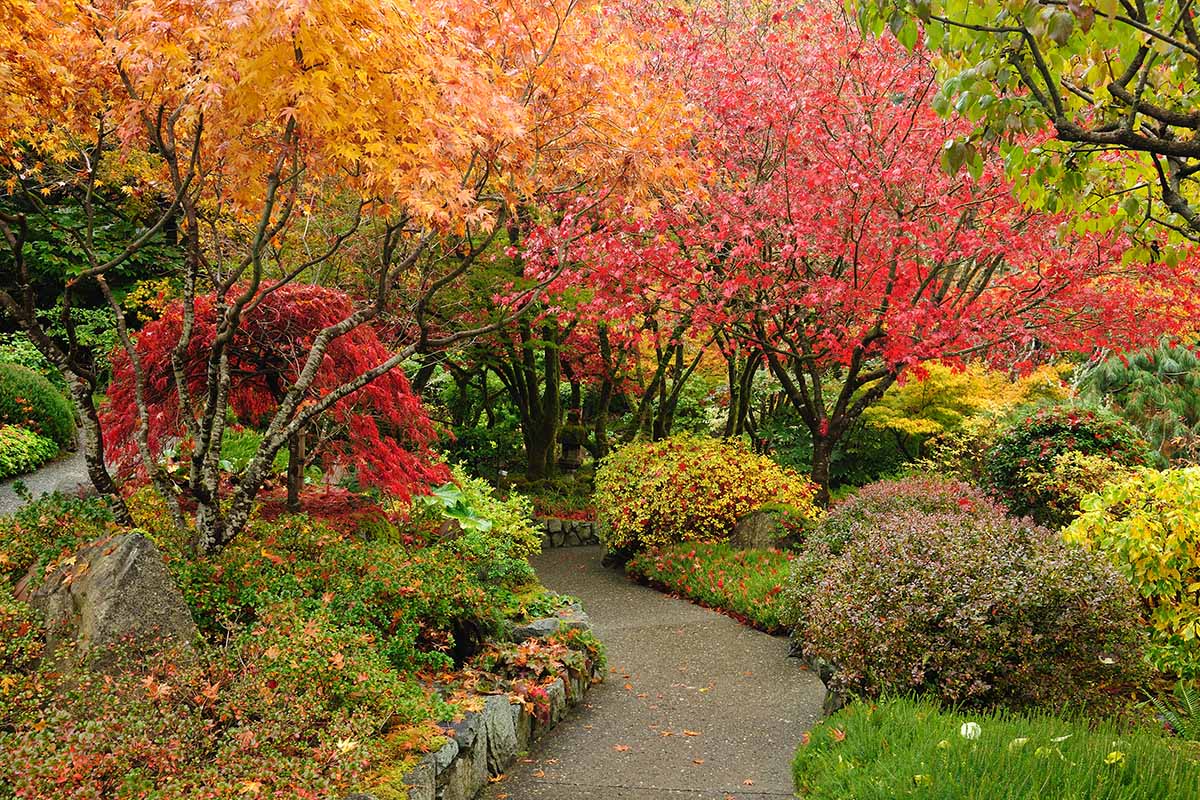
Wherever you live, we hope we’ve provided you with some selections that will make your fall garden as stunningly colorful as any spring landscape.
What did we miss? Share your fall favorites in the comments section below!
And for more inspiration to help you plan your garden, check out these guides next:
